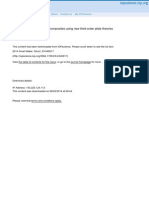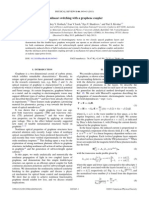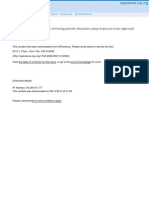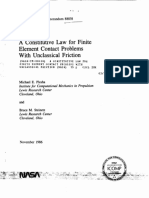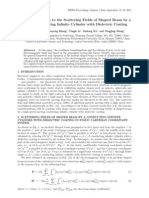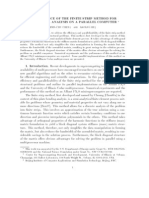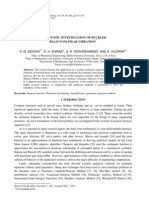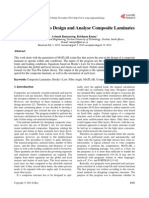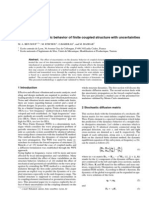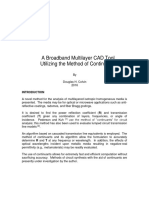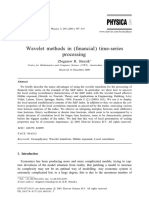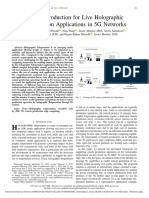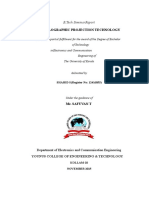Investigation of Dynamic Displacements of Lithographic Press Rubber Roller by Time Average Geometric Moire
Investigation of Dynamic Displacements of Lithographic Press Rubber Roller by Time Average Geometric Moire
Uploaded by
charles_boyle_3Copyright:
Available Formats
Investigation of Dynamic Displacements of Lithographic Press Rubber Roller by Time Average Geometric Moire
Investigation of Dynamic Displacements of Lithographic Press Rubber Roller by Time Average Geometric Moire
Uploaded by
charles_boyle_3Original Title
Copyright
Available Formats
Share this document
Did you find this document useful?
Is this content inappropriate?
Copyright:
Available Formats
Investigation of Dynamic Displacements of Lithographic Press Rubber Roller by Time Average Geometric Moire
Investigation of Dynamic Displacements of Lithographic Press Rubber Roller by Time Average Geometric Moire
Uploaded by
charles_boyle_3Copyright:
Available Formats
Optics and Lasers in Engineering 43 (2005) 951962
Investigation of dynamic displacements of
lithographic press rubber roller by time average
geometric moire
Minvydas Ragulskis
a,
, Rimas Maskeliunas
b
,
Liutauras Ragulskis
c
, Vytautas Turla
b
a
Kaunas University of Technology, Department of Mathematical Research in Systems, Studentu 50-222,
Kaunas LT-51368, Lithuania
b
Vilnius Gediminas Technical University, Department of Printing Machines, J. Basanaviciaus 28,
Vilnius LT-03224, Lithuania
c
Vytautas Magnus University, Department of Informatics, Vileikos 8, Kaunas LT-44404, Lithuania
Received 1 July 2004; received in revised form 1 October 2004; accepted 1 October 2004
Available online 24 December 2004
Abstract
Geometric moire fringe formation method is a classical well-established experimental
technique with numerous practical applications. This paper proposes the application of time-
average geometric moire analysis for the determination of dynamic displacements of the
lithographic press rubber roller. This optical measurement technique is a natural extension of
double-exposure geometric moire for the identication of dynamic displacements of vibrating
elastic structures. Experimental investigations prove the validity and effective practical
applicability of the method.
r 2004 Elsevier Ltd. All rights reserved.
Keywords: Geometric moire ; Fringes; Time average; Vibration; Press roller
ARTICLE IN PRESS
0143-8166/$ - see front matter r 2004 Elsevier Ltd. All rights reserved.
doi:10.1016/j.optlaseng.2004.10.004
Corresponding author. Tel.: +370 698 22456; fax: +370 373 30446.
E-mail address: minvydas.ragulskis@ktu.lt (M. Ragulskis).
1. Introduction
Double-exposure geometric moire [1] can produce valuable and meaningful
patterns of fringes. It is a well-established technique with various applications [2].
There exist numerous technical solutions for dynamic moire analysis [3]. A typical
example is when a free surface of liquid is illuminated through a grid focusing an
array of light and dark lines on the surface. Interpretation of the dynamic picture (or
series of static pictures) of grating can bring lots of useful information about the
motion of the surface. Another widely used application is the analysis of transient
mechanics of deformation exploiting laser moire interferometry [46].
Nevertheless, direct dynamic interpretation of structural vibrations from dynamic
pictures of moire grating is hardly possible due to a relatively high frequency of
resonance oscillations of the analysed structures. An alternative could be the
coupling of time-average techniques and geometric moire fringe analysis. It can be
noted that direct geometric moire analysis (not laser moire interferometry) is
considered when a grating of dark and white lines is plotted onto the surface of the
analysed body. Yet there are a few open questions. Will the patterns of fringes be
formed as the time-average techniques are used? And if the pattern of fringes is
formed, how can it be interpreted ? This paper tries to answer these questions and to
prove the applicability of time-average geometric moire for analysis of vibrating
elastic structures. Such a method of measurement does not require complex
experimental set-up and can provide valuable results in many practical applications.
2. One-dimensional model
For simplicity, a one-dimensional system is analysed rst. The moire grating in the
state of equilibrium is dened as a harmonic variation of grey scale in the range
between 0 (representing black colour) and 1 (representing white colour). Such a
denition of grating is well suited for numerical reconstruction of moire fringes [7].
The intensity is a continuous function, and line width is 50% of the pitch.
Superposition of two gratings (double exposure of the gratings in the state of
equilibrium and in the deformed state) produces a moire fringe pattern:
I
s
x; u
1
2
cos
2
p
l
x
_ _
cos
2
p
l
x u
_ _ _ _
1
2
1
2
cos
2p
l
1
u
2x
_ _
x
_ _
cos
p
l
u
_ _
; 1
where I
s
is the intensity in double exposure geometric moire , x, the longitudinal co-
ordinate, u, the displacement from the state of equilibrium at point x and l is the
parameter dening the pitch of grating. The rst term in Eq. (1) represents the grey-
scale level of the surface in the state of equilibrium and the second term represents
that in the state of deformation. Such a formulation of intensity enables
straightforward embedding of the results from nite element analysis to digital
computer plotting procedures. The centres of fringes will coincide with the locations
ARTICLE IN PRESS
M. Ragulskis et al. / Optics and Lasers in Engineering 43 (2005) 951962 952
where the intensity will be equal to 0.5. Thus, the relationship among fringe orders,
the pitch of the grating and the displacement can be derived from the condition
cosp=lu 0:
u l n
1
2
_ _
; n 1; 2; . . . ; (2)
where n is the fringe order. Each new fringe indicates an increase or decrease of
specimen displacement by one grating pitch (component of the displacement
perpendicular to the reference grating lines). If the displacement from the state of
equilibrium u is assumed to be a linear function of x, the resulting intensity
distribution takes the form of beatings (Fig. 1). Such an effect can be successfully
exploited in the procedures building computer-generated moire fringes from nite
element calculations [7].
Alternatively, double-exposure geometric moire can be constructed as a super-
position of two gratings, one of which is in the deformed state and the other is also in
the deformed state but with the opposite deformation. Then the following fringe
pattern will be produced:
I
so
x; u
1
2
cos
2
p
l
x u
_ _
cos
2
p
l
x u
_ _ _ _
1
2
1
2
cos
2p
l
x
_ _
cos
2p
l
u
_ _
3
ARTICLE IN PRESS
Fig. 1. I
1
(x), I
2
(x), I
S
(x) and I
d
(x) at l 0:8 and u kx at k 0:1:
M. Ragulskis et al. / Optics and Lasers in Engineering 43 (2005) 951962 953
where I
so
is the intensity of double exposure moire when gratings with opposite
deformations are superposed. Thus, the relationship among fringe orders, the pitch
of the grating and the displacement takes the following form:
u
l
2
n
1
2
_ _
; n 1; 2; . . . : (4)
Let us consider the previously mentioned one-dimensional model with the
assumption that an elastic structure performs harmonic oscillations and the
amplitudes (maximum displacements from the status of equilibrium) are u(x). If
the time of exposition is much longer than the period of oscillations, the resulting
pattern is formed as an integral sum of the continuous process of motion:
I
d
x; u lim
T!1
1
2T
_
T
0
1 cos
2p
l
x u sinot j
_ _ _ _
dt
o
2p
_
2pj=o
j=o
cos
2
p
l
x u sinot j
_ _
dt
o
2p
m
i1
cos
2
p
l
x u sin o
j
o
i 1
2p
mo
_ _
j
_ _ _ _
2p
mo
_ _
1
m
m
i1
cos
2
p
l
x u sin
2p
m
i 1
_ _ _ _ _ _ _ _
; 5
where I
d
is the intensity of illumination in dynamic moire fringe analysis, T, the
exposure time, o; the angular frequency of oscillations, j; the phase and m, the
number of discrete states in a period of oscillations.
The rst equality in Eq. (5) follows from the periodicity of harmonic function. The
second approximate equality builds the ground for approximate numerical technique
of the reconstruction of the pattern of fringes. The greater the value of m, the better
the quality. It can be noted that neither o nor j has any effect on the pattern of
fringes. But
lim
T!1
1
2T
_
T
0
1 cos
2p
l
x u sinot j
_ _ _ _
dt
1
2
lim
T!1
1
2T
_
T
0
cos
2p
l
x
_ _
cos
2p
l
u sinot j
_ _
dt
lim
T!1
1
2T
_
T
0
sin
2p
l
x
_ _
sin
2p
l
u sinot j
_ _
dt
1
2
1
2
cos
2p
l
x
_ _
J
0
2p
l
u
_ _
; 6
where J
0
, is the zero-order Bessel function of the rst kind:
J
0
a lim
T!1
1
T
_
T
0
expja sinot jdt
_ _
(7)
ARTICLE IN PRESS
M. Ragulskis et al. / Optics and Lasers in Engineering 43 (2005) 951962 954
It can be noted that integrals
lim
T!1
1
2T
_
T
0
sin
2p
l
u sinot j
_ _
dt and
lim
T!1
1
T
_
T
0
sina sinot j dt
converge to zero due to the non-evenness of the sine function.
The surface intensities for double exposure and time-average geometric moire are
illustrated in Fig. 1, where I
1
(x) is the equilibrium state and I
2
(x) the deformed state.
Eq. (6) enables explicit construction of the envelope function which modulates the
grating cos2p=lx and characterises the formation of fringes:
Eu
1
2
1
2
J
0
2p
l
u
_ _
(8)
where E stands for the envelope function (Fig. 2a). Though the decay of intensity of
illumination at increasing amplitudes is quite strong, it is not as fast as in time
average holography
1
, where the decay of intensity of illumination is dened as
Hu J
0
2p
l
u
_ _ _ _
2
; (9)
where H is the intensity of illumination in the time-average holographic image. It is
important to note that the intensity of illumination in time-average moire
applications converges to 0.5 (instead of 0 in holographic analysis) at increasing
amplitudes, and special digital image brightening techniques [8] can be avoided.
From Eq. (6), it is clear that the accuracy of numerical reconstruction of the image
is determined by the parameter mthe number of discrete states in a period of
oscillations ascertains the character of the reconstructed envelope function (explicitly
dened by Eq. (8)). The procedure of numerical reconstruction presented in Eq. (6)
does not explicitly dene the envelope function. But it is still possible to dene that
function using a similar technique as used in Eq. (8). It can be noted that the extreme
values of the last term in Eq. (6) occur at x 0 and x l=2: Then,
E
m
u
1
m
m
i1
cos
2 p
l
sin
2p
m
i 1
_ _
u
_ _ _ _
1
m
m
i1
sin
2 p
l
sin
2p
m
i 1
_ _
u
_ _ _ _
_
_
(10)
where E
m
is the reconstructed envelope function at predened m. Fig. 2a presents the
numerically reconstructed envelope lines at m 22; which guarantees sufcient
accuracy of reconstruction of the rst ve fringes. The relationship between the
number of correctly reconstructed fringes and the number of discrete states in a
period of harmonic oscillations is presented in Fig. 2b.
ARTICLE IN PRESS
M. Ragulskis et al. / Optics and Lasers in Engineering 43 (2005) 951962 955
3. Interpretation of the fringe pattern (quantitative analysis of deformation)
The fringe pattern produced by time-average geometric moire is directly related to
the displacement eld, as in double exposure geometric moire . The only difference is
that the relationship between the number of fringes and the value of displacement in
ARTICLE IN PRESS
Fig. 2. (a) Envelope function at l 0:25; solid line stands for the analytical denition and dashed lines for
the numerical reconstruction at m 22: (b) Relationship between the number of correctly reconstructed
fringes and parameter m.
M. Ragulskis et al. / Optics and Lasers in Engineering 43 (2005) 951962 956
time-average moire analysis is non-linear. Explicitly, this relationship can be derived
from Eq. (8). The centres of the fringes coincide with the isolines corresponding to
the solution of equality Eu
1
2
: Thus, the explicit relationship among the fringe
order, pitch of the grating and dynamic displacement is obtained from the condition
requiring that the value of the Bessel function is zero:
u
l
2p
r
n
; (11)
where r
n
is the nth root of the zero-order Bessel function of the rst kind. It can be
noted that the values of the roots of the zero-order Bessel function of the rst kind
are available in classical texts [9]. The relationship between the non-dimensional
dynamic displacement and the fringe number is presented in Fig. 3.
It can be noted that the object of moire analysis is to measure displacement
components normal to the grating lines. Both components of the two-dimensional
displacement vector can be determined from two experiments with mutually
orthogonal gratings. This is true both for double exposure and time-average
geometric moire .
4. Experimental validation of the method
The goal of experimental time-average moire analysis is to validate the method. A
grating of dark and white lines is drawn on the surface of rubber specimens which
are mounted to a shaker system (Fig. 4).
ARTICLE IN PRESS
Fig. 3. Relationship between the non-dimensional displacement and the fringe number.
M. Ragulskis et al. / Optics and Lasers in Engineering 43 (2005) 951962 957
One rubber specimen is produced with horizontal grating and another with
vertical grating. The grating pitch is 1 mm, line width is half of the pitch, and driving
frequency of the shaker table is 51 Hz, which corresponds to the second resonance
frequency of the rubber specimens. A digital photo camera with exposition time
T 1:5 seconds is used. The produced images are presented in Figs. 5a and b. It can
be noted that the high sharpness of the grating is preserved in the motionless zones of
the rubber specimen. The fringes can be identied with the naked eye in live
experiments, although for higher fringe numbers their contrast decreases.
The produced experimental time-average moire fringes enable the straightforward
interpretation of dynamic deformations. For example, nine fringes are visible to the
left of the motionless zone in Fig. 5a. This means that the maximum dynamic
displacement of the end of the rubber specimen in the vertical direction is u=l
r
9
=2p (from Eq. (11)), and here r
9
27; 4927: Thus, the maximum dynamic
displacement from the status of equilibrium is 4,3756 pitches, or 8,7512 pitches from
maximum displacement up and maximum displacement down in the vertical
direction. It is easy to count the grating lines between the maximum deections at the
region of the end section of the rubber specimen. The number of lines is about 8.
That shows perfect coincidence between experimental and theoretical results.
5. Experimental analysis of lithographic press rubber roller
Circular time-average moire has many advantageous features over other
experimental methods for the analysis of rotating circular objects. This is clearly
illustrated in a time-average photo of a rotating lithographic press rubber roller train
(Fig. 6). No interpretable patterns would be formed at all if the moire grating were
not formed as an array of concentric circles.
The intensity of illumination for time-average circular geometric moire with
concentric grating can be expressed as an integral average of variation of radial
ARTICLE IN PRESS
Fig. 4. View of the experimental set-up.
M. Ragulskis et al. / Optics and Lasers in Engineering 43 (2005) 951962 958
displacements:
I
dr
x; y; u; v
lim
T!1
1
2T
_
T
0
1 cos
2p
l
x ut
2
y vt
2
_
_ _ _ _
dt; 12
where I
dr
is the intensity of illumination for time-average circular geometric moire
with concentric grating, l is a constant determining the distance between concentric
lines in the status of equilibrium, and u(t) and v(t) are in-plane dynamic
ARTICLE IN PRESS
Fig. 5. (a)Experimental time-average moire fringes (vertical grating). (b) Experimental time-average moire
fringes (horizontal grating).
M. Ragulskis et al. / Optics and Lasers in Engineering 43 (2005) 951962 959
displacements in cartesian frame. It can be noted that concentric grating enables the
registration of radial displacements and is insensitive to angular displacements
(rotation). Alternatively, radial moire grating can be used for circular objects. Such
grating would be sensitive to angular, not radial displacements (but not applicable
for rotating objects):
I
da
x; y; u; v lim
T!1
1
2T
_
T
0
1 cos k tan
1
x ut
y vt
_ _ _ _
dt; (13)
where I
da
is the intensity of illumination for time-average circular geometric moire
with radial grating and k is a constant determining the number of radial lines.
If the roller train vibrates, time-average circular geometric moire with concentric
grating can provide valuable information about dynamic deformations. This is
ARTICLE IN PRESS
Fig. 6. Time-average photo of a rotating lithographic press rubber roller train.
Fig. 7. Time-average photograph of the vibrating rubber roller.
M. Ragulskis et al. / Optics and Lasers in Engineering 43 (2005) 951962 960
illustrated in Fig. 7, where the rubber roller does not turn and its axis is motionlessly
xed. The pitch of circular grating is 1 mm, and line width is half the pitch. The steel
roller performs harmonic vibrations, the frequency of vibrations is 20 Hz, and
exposure time is 2 s. Interference fringes in the contact zone are clearly visible with
the naked eye. Noteworthy is the image of the steel roller where two maximum
deections from the status of equilibrium are best registered in the time-average
photo due to the fact that the velocity of the vibrating body is small around the
regions of maximum displacements.
Digital processing of the image of the contact zone (Fig. 8) provides an even
clearer picture of the interference fringes. It can be noted that the interpretation of
fringes is different from double-exposure geometric moire as the formation of fringes
is governed by time-average moire and is dened explicitly by Eq. (11). For
concentric grating every fringe will determine dynamic displacement in the radial
direction and the magnitude of displacement can be found from Eq. (11). Ordinary
fringe counting techniques can be used for determination of the fringe order.
It is important to note that time-average geometric moire is a non-contact whole-
eld technique and provides information on dynamic deformations which can be
easily registered and quantied in the domain of the whole analysed object. The
advantages of this optical technique are especially clear when applied for the analysis
of dynamic deformations of the rubber layer of the lithographic press roller.
6. Concluding remarks
Time-average geometric moire for analysis of in-plane vibrations of elastic
structures is proposed in this paper. Apparently, the fact that the intensity of higher
fringes is blurred was hiding this method amongst other non-contact whole-eld
experimental techniques for analysis of structural vibrations.
This paper proves that such a method is feasible for the analysis of vibrations. It
has many advantageous features it is a straightforward method and does not
ARTICLE IN PRESS
Fig. 8. Digitally processed image of the contact zone with enumerated fringes.
M. Ragulskis et al. / Optics and Lasers in Engineering 43 (2005) 951962 961
require a complex experimental set-up. It is even more simple than double-exposure
geometric moire no articial superposition of the reference image and the image of
the object in the deformed state is necessary. Naturally, the interpretation of fringe
patterns in time-average geometric moire is different from the double-exposure
geometric moire . But this fact does not decrease the practical value of the method,
which can be effectively exploited for the analysis of vibrating elastic structures.
References
[1] Kobayashi AS, editor. Handbook on experimental mechanics. 2nd ed. SEM; 1993.
[2] Post D, Han B, Ifju P. High sensitivity moire : experimental analysis for mechanics and materials.
Berlin: Springer Verlag; 1997.
[3] Indebetoun G, Czarnek R. Selected papers on optical moire and applications. Virginia Polytechnic
Institute and State University; 1992.
[4] Huimin X, Guotao W, Fulong D, Guangjun Z, Xingfu L, Fangju Z, et al. The dynamic deformation
measurement of the high speed heated LY12 aluminium plate with moire interferometry. J Mater
Process Technol 1998;83(13):15963.
[5] Deason VA, Epstein JS, Abdallah A. Dynamic diffraction moire : theory and applications. Opt Lasers
Eng 1990;12(23):17387.
[6] Kokaly MT, Lee J, Kobayashi AS. Moire interferometry for dynamic fracture study. Opt Lasers Eng
2003;40(4):23147.
[7] Ragulskis M, Maskeliunas R, Ragulskis L. Plotting moire fringes for circular structures from FEM
results. Exp Techniques 2002;26(1):315.
[8] Ragulskis M, Palevicius A, Ragulskis L. Plotting holographic interferograms for visualization of
dynamic results from nite-element calculations. Int J Numer Meth Engng 2003;56:164759.
[9] West CM. Holographic interferometry. New York: Wiley; 1979.
ARTICLE IN PRESS
M. Ragulskis et al. / Optics and Lasers in Engineering 43 (2005) 951962 962
You might also like
- Aerospace Structural Metals HandbookDocument91 pagesAerospace Structural Metals Handbookcharles_boyle_3100% (1)
- Chapter 5 Graphic Communication p70-87Document28 pagesChapter 5 Graphic Communication p70-87api-152132438No ratings yet
- KHT Korean Hand TherapyDocument6 pagesKHT Korean Hand TherapyCamilo100% (3)
- Turbulent Fracture SurfacesDocument5 pagesTurbulent Fracture Surfacesstephane VernedeNo ratings yet
- Modeling of Lamb Waves in Composites Using New Third-Order Plate TheoriesDocument15 pagesModeling of Lamb Waves in Composites Using New Third-Order Plate TheoriesesatecNo ratings yet
- A New Analytical Technique For Vibration Analysis of Non Proportionally Dampoed BeamsDocument18 pagesA New Analytical Technique For Vibration Analysis of Non Proportionally Dampoed Beamsmatze1395.sNo ratings yet
- A Two-Scale Damage Model With Material Length: Cristian DascaluDocument8 pagesA Two-Scale Damage Model With Material Length: Cristian DascaluyycNo ratings yet
- Shear Band Formation in Granular Materials: A Micromechanical ApproachDocument7 pagesShear Band Formation in Granular Materials: A Micromechanical ApproachgeoanagoNo ratings yet
- 1978 - Jelínek-Kropáček1978 Article StatisticalProcessingOfAnisotrDocument13 pages1978 - Jelínek-Kropáček1978 Article StatisticalProcessingOfAnisotrluis velderrain RojasNo ratings yet
- Graphene CouplerDocument5 pagesGraphene Couplerpobio-1No ratings yet
- How To Get The Yield Locus of An Adhesive Powder From A Single Numerical ExperimentDocument6 pagesHow To Get The Yield Locus of An Adhesive Powder From A Single Numerical Experimentsubhash thakurNo ratings yet
- Analysis of The Moiré Pattern of Moving Periodic Structures Using Reciprocal Vector ApproachDocument10 pagesAnalysis of The Moiré Pattern of Moving Periodic Structures Using Reciprocal Vector Approachklounas2003No ratings yet
- Fingerprint Images Enhancement Using Diffusion Tensor: Ferielromdhane@yahoo - FR Benzartif@Document6 pagesFingerprint Images Enhancement Using Diffusion Tensor: Ferielromdhane@yahoo - FR Benzartif@Abir BaigNo ratings yet
- Journal of TurbulenceDocument29 pagesJournal of TurbulenceUmair IsmailNo ratings yet
- Three Dimensional Vibration Analysis of Crystal Plates Via Ritz MethodDocument10 pagesThree Dimensional Vibration Analysis of Crystal Plates Via Ritz Method王轩No ratings yet
- P.G. Kevrekidis Et Al - Three-Dimensional Solitary Waves and Vortices in A Discrete Nonlinear Schrodinger LatticeDocument4 pagesP.G. Kevrekidis Et Al - Three-Dimensional Solitary Waves and Vortices in A Discrete Nonlinear Schrodinger Lattice23213mNo ratings yet
- Uniform Asymptotic Formulae For The Spheroidal Radial FunctionDocument9 pagesUniform Asymptotic Formulae For The Spheroidal Radial FunctionLuLa_IFNo ratings yet
- Modeling of Large Deformations of Hyperelastic MaterialsDocument4 pagesModeling of Large Deformations of Hyperelastic MaterialsSEP-PublisherNo ratings yet
- Multi Scale CrackDocument17 pagesMulti Scale CrackSakib RajiunNo ratings yet
- Vibration Analysis of Two-Dimensional Structures Using Micropolar ElementsDocument14 pagesVibration Analysis of Two-Dimensional Structures Using Micropolar Elementsmohammad zalakiNo ratings yet
- (WFD Paper) 22 CMSIM 2012 Dubey Kapila 1 241-256Document16 pages(WFD Paper) 22 CMSIM 2012 Dubey Kapila 1 241-256ChandreshNo ratings yet
- Beams Free Transverse Vibrations of Nano-To-Micron Scale:, 2977-2995 2006 Mingtian XuDocument20 pagesBeams Free Transverse Vibrations of Nano-To-Micron Scale:, 2977-2995 2006 Mingtian XuEric AmbroziniNo ratings yet
- Classification of Initial State Granularity Via 2d Fourier ExpansionDocument10 pagesClassification of Initial State Granularity Via 2d Fourier ExpansionFelicia YoungNo ratings yet
- Topological Aspect of Disclinations in Two-Dimensional MeltingDocument6 pagesTopological Aspect of Disclinations in Two-Dimensional MeltingBayer MitrovicNo ratings yet
- Dao động tự do của thành mỏng ko đối xứngDocument18 pagesDao động tự do của thành mỏng ko đối xứngThái Âu CôngNo ratings yet
- Methodwaveletformultifractalimageanalisis Anisotropic IsotropicDocument34 pagesMethodwaveletformultifractalimageanalisis Anisotropic IsotropicBruno Barra PezoNo ratings yet
- Damage 99Document29 pagesDamage 99ing_costeroNo ratings yet
- 3D Petrophysical Modeling Using Complex Seismic Attributes and Limited Well Log DataDocument5 pages3D Petrophysical Modeling Using Complex Seismic Attributes and Limited Well Log DataMehdl EftekharlNo ratings yet
- Simulation Programs For The Analysis in PhotonicsDocument31 pagesSimulation Programs For The Analysis in PhotonicsAmiroucheNo ratings yet
- A Simplified Method For Natural Frequency Analysis of A Multiple Cracked Beam 2001 Journal of Sound and VibrationDocument15 pagesA Simplified Method For Natural Frequency Analysis of A Multiple Cracked Beam 2001 Journal of Sound and VibrationABHISHEK KUMAR SAHUNo ratings yet
- Construction and Calibration of A Goniometer To Measure Contact Angles and Calculate The Surface Free Energy in Solids With Uncertainty AnalysisDocument25 pagesConstruction and Calibration of A Goniometer To Measure Contact Angles and Calculate The Surface Free Energy in Solids With Uncertainty Analysisonline onlineNo ratings yet
- Fem Contact ProblemDocument20 pagesFem Contact ProblemAnand MishraNo ratings yet
- Theoretical Foundations ofDocument17 pagesTheoretical Foundations ofSakhi ShokouhNo ratings yet
- An Analytic Solution To The Scattering Fields of Shaped Beam by A Moving Conducting Infinite Cylinder With Dielectric CoatingDocument5 pagesAn Analytic Solution To The Scattering Fields of Shaped Beam by A Moving Conducting Infinite Cylinder With Dielectric CoatingDyra KesumaNo ratings yet
- Elastic Wave Finite Difference Modelling As A Practical Exploration ToolDocument16 pagesElastic Wave Finite Difference Modelling As A Practical Exploration ToolDaniel R PipaNo ratings yet
- Dynamic Analysis of A Planar Rigid-Link Mechanism WithDocument11 pagesDynamic Analysis of A Planar Rigid-Link Mechanism Withyangee1201No ratings yet
- 3 AnnDocument16 pages3 AnnDilleswararao ChintalaNo ratings yet
- Extended Rotation-Free Shell Triangles With Transverse Shear Deformation EffectsDocument17 pagesExtended Rotation-Free Shell Triangles With Transverse Shear Deformation Effectsrs0004No ratings yet
- Free Vibration of Laminated Plates by A Variable-Kinematic Chebyshev-Ritz MethodDocument3 pagesFree Vibration of Laminated Plates by A Variable-Kinematic Chebyshev-Ritz MethoddozioNo ratings yet
- Performance of The Finite Strip Method For Structural Analysis On A Parallel ComputerDocument14 pagesPerformance of The Finite Strip Method For Structural Analysis On A Parallel ComputerFabio OkamotoNo ratings yet
- Li 2000Document19 pagesLi 2000emad samirNo ratings yet
- AttachmentDocument12 pagesAttachmentRafael Cardoso100% (1)
- Physica Status Solidi B - 1 May 1972 - Trinkaus - On Determination of The Double Force Tensor of Point Defects in CubicDocument13 pagesPhysica Status Solidi B - 1 May 1972 - Trinkaus - On Determination of The Double Force Tensor of Point Defects in Cubiczxl11840No ratings yet
- Douglas-Danciu2020 Article NomogramToHelpExplainProbabiliDocument8 pagesDouglas-Danciu2020 Article NomogramToHelpExplainProbabiliVictor Manuel UribeNo ratings yet
- Response Spectrum Analysis of Structures Subjected To Seismic ActionsDocument19 pagesResponse Spectrum Analysis of Structures Subjected To Seismic ActionsRamanathan GnanasambandamNo ratings yet
- 1 Modeling Crack Singularities in FEM/X-FEMDocument11 pages1 Modeling Crack Singularities in FEM/X-FEMmilad66tehNo ratings yet
- Center For Theoretical Physics, University of Twente, P.O.B. 217, 7500 A E Enschede, The NetherlandsDocument13 pagesCenter For Theoretical Physics, University of Twente, P.O.B. 217, 7500 A E Enschede, The Netherlandskhanafzaal2576100% (1)
- Application of Bloch NMR Flow Equation Analytical Models For Magnetic Resonance ImagingDocument21 pagesApplication of Bloch NMR Flow Equation Analytical Models For Magnetic Resonance Imaginga_minisoft2005No ratings yet
- Buckled Beam Nonlinear VibrationDocument10 pagesBuckled Beam Nonlinear Vibrationhmsedighi459No ratings yet
- Engineering20101100005 44076873Document13 pagesEngineering20101100005 44076873Abdalla Mohamed AbdallaNo ratings yet
- Nitin Eng Journal PDFDocument16 pagesNitin Eng Journal PDFpdhurveyNo ratings yet
- Variability of Dynamic Behavior of Finite Coupled Structure With UncertaintiesDocument4 pagesVariability of Dynamic Behavior of Finite Coupled Structure With UncertaintieswalhalassaadNo ratings yet
- Yoo1994 HybridDocument18 pagesYoo1994 HybridBrendon MenezesNo ratings yet
- Applied Mathematics and Mechanics: (English Edition)Document10 pagesApplied Mathematics and Mechanics: (English Edition)asifiqbal84No ratings yet
- Small Satellites Emc StudyDocument5 pagesSmall Satellites Emc StudypathmakerpkNo ratings yet
- Reconstruction of A Fracture Process Zone During Tensile Failure of Quasi-Brittle MaterialsDocument14 pagesReconstruction of A Fracture Process Zone During Tensile Failure of Quasi-Brittle MaterialsGabriel PatrunoNo ratings yet
- Moving Force Identification: A Time Domain Method: Journal of Sound and VibrationDocument22 pagesMoving Force Identification: A Time Domain Method: Journal of Sound and VibrationAugusto César Santos PeixotoNo ratings yet
- MultiLayer DONEDocument13 pagesMultiLayer DONEDouglas ColvinNo ratings yet
- 1 s2.0 S0378437101001017 Main PDFDocument13 pages1 s2.0 S0378437101001017 Main PDFdocdocopenupNo ratings yet
- Manual On Experimental Stress AnalysisDocument31 pagesManual On Experimental Stress AnalysisrmontandonNo ratings yet
- A Numerical Solution of The Dispersion Equation of The Guided Wave Propagation in N-Layered MediaDocument27 pagesA Numerical Solution of The Dispersion Equation of The Guided Wave Propagation in N-Layered MediaAndrea ProsperiNo ratings yet
- Method of Moments for 2D Scattering Problems: Basic Concepts and ApplicationsFrom EverandMethod of Moments for 2D Scattering Problems: Basic Concepts and ApplicationsNo ratings yet
- Seamless Stainless Steel Tube: Other Sizes Available On RequestDocument1 pageSeamless Stainless Steel Tube: Other Sizes Available On Requestcharles_boyle_3No ratings yet
- Steel Cross ReferenceDocument4 pagesSteel Cross Referencecharles_boyle_3No ratings yet
- Din 2448Document3 pagesDin 2448Cristian Adrian ANo ratings yet
- 1.0401 - C15Document1 page1.0401 - C15charles_boyle_3No ratings yet
- Needle en b173-217Document45 pagesNeedle en b173-217charles_boyle_3No ratings yet
- Unit Weight ScheduleDocument1 pageUnit Weight Schedulecharles_boyle_3No ratings yet
- MR 11plct Frevzfeb12Document496 pagesMR 11plct Frevzfeb12charles_boyle_3No ratings yet
- Keyway ChartDocument3 pagesKeyway Chartcharles_boyle_367% (3)
- MR 15plct Frevtfeb12Document476 pagesMR 15plct Frevtfeb12charles_boyle_30% (1)
- Kurvenrollen NTNDocument30 pagesKurvenrollen NTNcharles_boyle_3No ratings yet
- Cam FollowersDocument8 pagesCam Followerscharles_boyle_3100% (1)
- Gravity Die Castings Tolerance Guide Functional Dimensions Millimetres Dimension ToleranceDocument1 pageGravity Die Castings Tolerance Guide Functional Dimensions Millimetres Dimension Tolerancecharles_boyle_3No ratings yet
- E 1421Document11 pagesE 1421charles_boyle_3No ratings yet
- LM4 Alloy DetailDocument5 pagesLM4 Alloy Detailcharles_boyle_3No ratings yet
- LM9 Alloy DetailDocument3 pagesLM9 Alloy Detailcharles_boyle_3No ratings yet
- A356.0 Alloy DetailDocument2 pagesA356.0 Alloy Detailcharles_boyle_3No ratings yet
- BS2L99 Alloy DetailDocument2 pagesBS2L99 Alloy Detailcharles_boyle_3No ratings yet
- Icces 2008 007 023Document20 pagesIcces 2008 007 023charles_boyle_3No ratings yet
- Advancements in Electric MachinesDocument56 pagesAdvancements in Electric Machinescharles_boyle_3No ratings yet
- Remote Production For Live Holographic Teleportation Applications in 5G NetworksDocument13 pagesRemote Production For Live Holographic Teleportation Applications in 5G NetworksshivaNo ratings yet
- Lasers in The ConservationDocument508 pagesLasers in The ConservationBilgin Gokgoz100% (2)
- Modern Science: VedantaDocument45 pagesModern Science: VedantaSandip S NagareNo ratings yet
- Deep-Learning-Generated HolographyDocument5 pagesDeep-Learning-Generated Holographywangxz1983No ratings yet
- Liu 2016 - Resolution Improvement For Enhancing Interference Fringes of Digital Holograms With Near Infrared IlluminanceDocument8 pagesLiu 2016 - Resolution Improvement For Enhancing Interference Fringes of Digital Holograms With Near Infrared IlluminancedgNo ratings yet
- The Optics of SpectrosDocument61 pagesThe Optics of SpectrosudacurieNo ratings yet
- Empowerment Technologies: Quarter 3 - 8: Imaging and Design Fo R The Online Environment IDocument14 pagesEmpowerment Technologies: Quarter 3 - 8: Imaging and Design Fo R The Online Environment IShaira Jane Estrella UcolNo ratings yet
- Non Conventional MarkDocument24 pagesNon Conventional MarkVirendraSinghThakurNo ratings yet
- The Wholeness of Nature Goethe's Way Toward A Science of Conscious Participation in NatureDocument217 pagesThe Wholeness of Nature Goethe's Way Toward A Science of Conscious Participation in NatureJennet WNo ratings yet
- Brittle Coating MethodsDocument8 pagesBrittle Coating MethodssakthiNo ratings yet
- 1982 Bookmatter EssentialsOfMedicalUltrasoundDocument25 pages1982 Bookmatter EssentialsOfMedicalUltrasoundGeorgiana PcsNo ratings yet
- Security SolutionsDocument3 pagesSecurity SolutionsclubedovarNo ratings yet
- Star Trek - Klingon Academy - Manual - PCDocument39 pagesStar Trek - Klingon Academy - Manual - PCAnonymous utXYfMAXNo ratings yet
- Advanced Optics Lab at SJSUDocument16 pagesAdvanced Optics Lab at SJSUAli KhumaeniNo ratings yet
- Ruby Pulse Laser and HologramsDocument4 pagesRuby Pulse Laser and Hologramsmrkk 75No ratings yet
- HologramDocument2 pagesHologramchinhour thavNo ratings yet
- Lawrence E Murr (Editor) - Electron and Ion Microscopy and Microanalysis - Principles and Applications, Second Edition,-CRC Press (1991)Document54 pagesLawrence E Murr (Editor) - Electron and Ion Microscopy and Microanalysis - Principles and Applications, Second Edition,-CRC Press (1991)Elkin ZapataNo ratings yet
- Microsoft HololensDocument17 pagesMicrosoft HololensPadma PatlollaNo ratings yet
- IGCSE ICT - Emerging Technologies (For The New Syllabus)Document10 pagesIGCSE ICT - Emerging Technologies (For The New Syllabus)Benjamin MuganziNo ratings yet
- Optical ComputerDocument19 pagesOptical ComputerUtsav PrakashNo ratings yet
- The Andromedan Compendium - 7bDocument10 pagesThe Andromedan Compendium - 7bAnonymous XSNBQQ4yNo ratings yet
- The Virtual Retinal Display (VRD) Is ADocument39 pagesThe Virtual Retinal Display (VRD) Is AanushaareddyNo ratings yet
- 3D Holographic Projection Technology: B.Tech SeminarreportDocument35 pages3D Holographic Projection Technology: B.Tech SeminarreportBismi ĹLaNo ratings yet
- Media Information LiteracyDocument45 pagesMedia Information Literacyrose maryNo ratings yet
- Genetic Combinations: The Discovery From The Bucegi MountainsDocument4 pagesGenetic Combinations: The Discovery From The Bucegi MountainsnikoNo ratings yet
- Capturing Videos at 60 Frames Per Second UsingDocument12 pagesCapturing Videos at 60 Frames Per Second UsingalejandrofedeNo ratings yet
- 3D Holographic Projection TechnologyDocument32 pages3D Holographic Projection TechnologyPranay GoudaNo ratings yet
- Lab Report For Optical Measurement PDFDocument4 pagesLab Report For Optical Measurement PDFBilly BrownNo ratings yet




